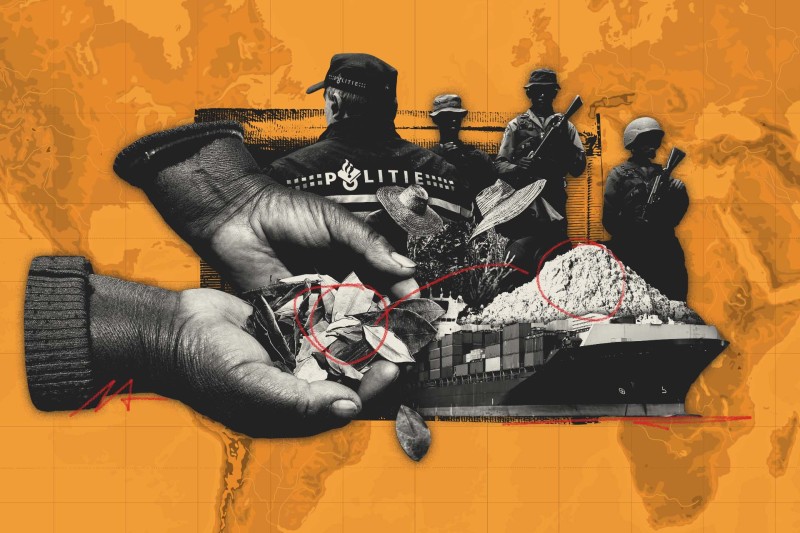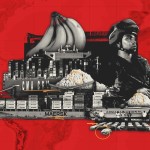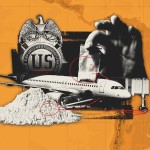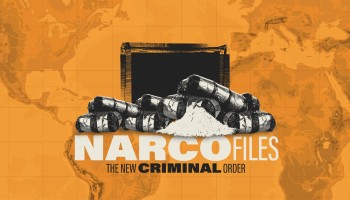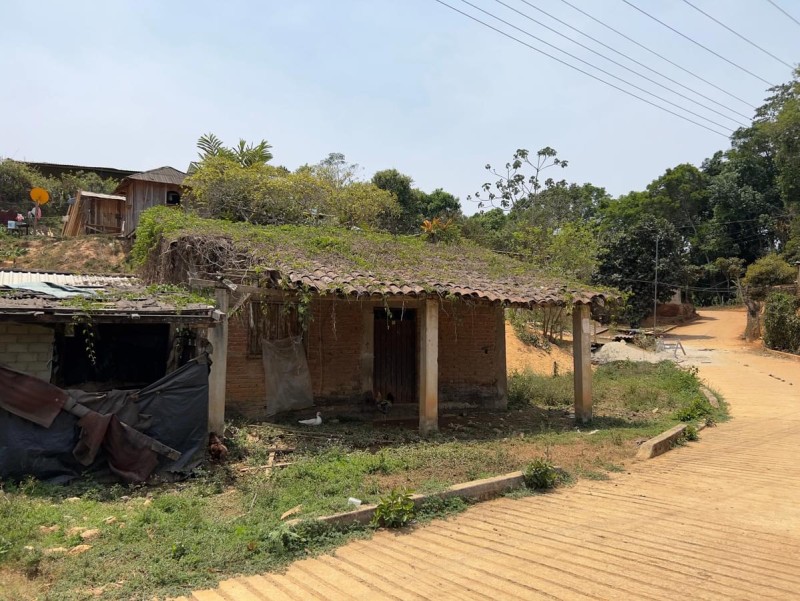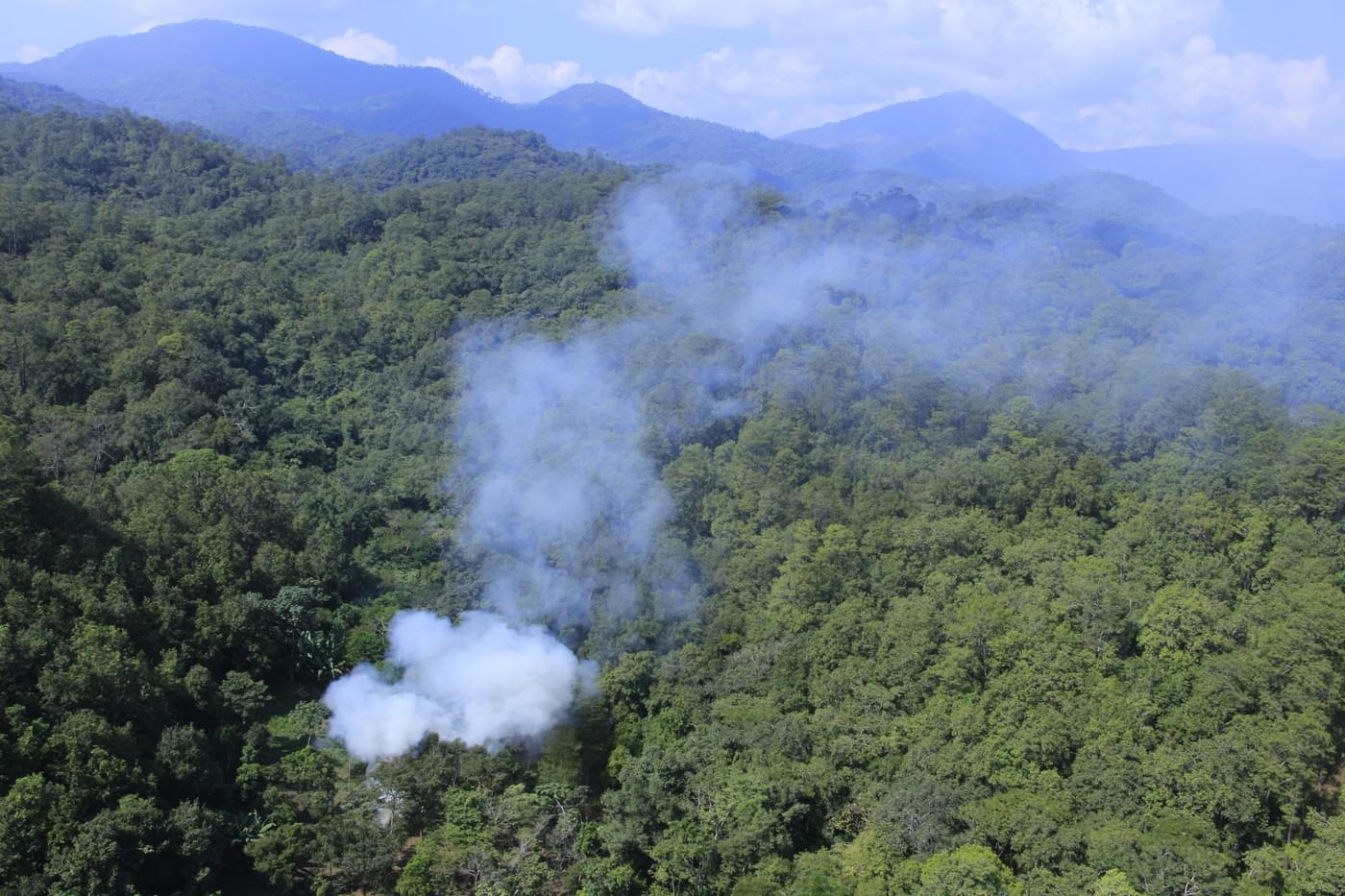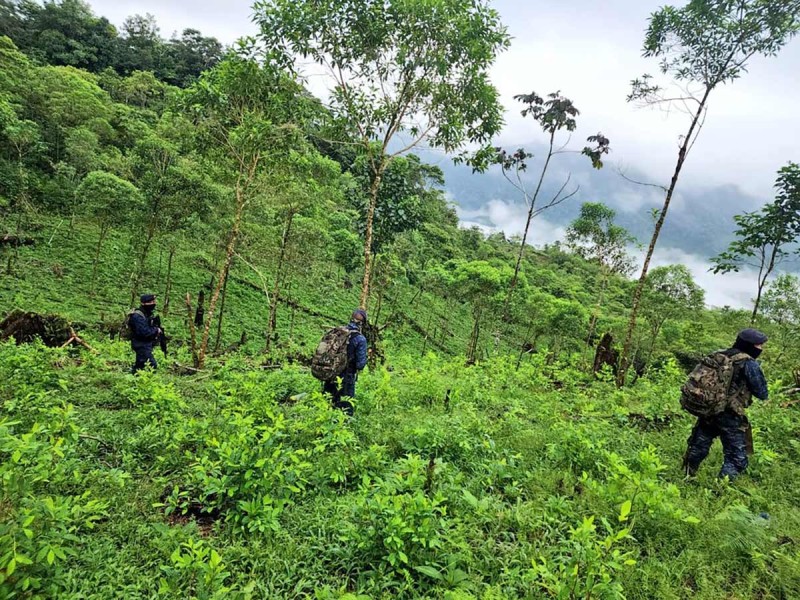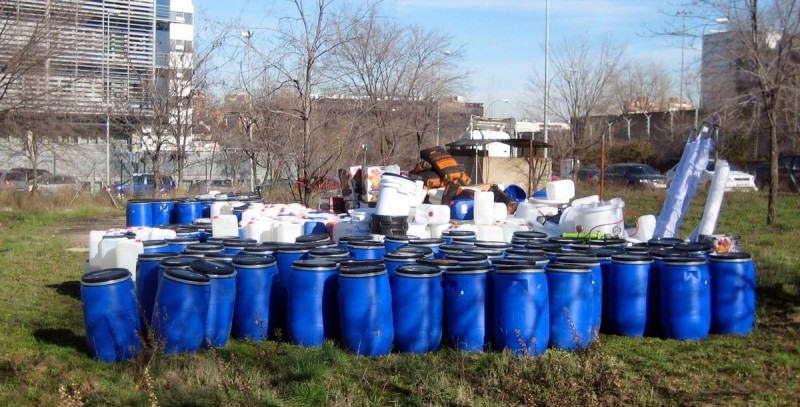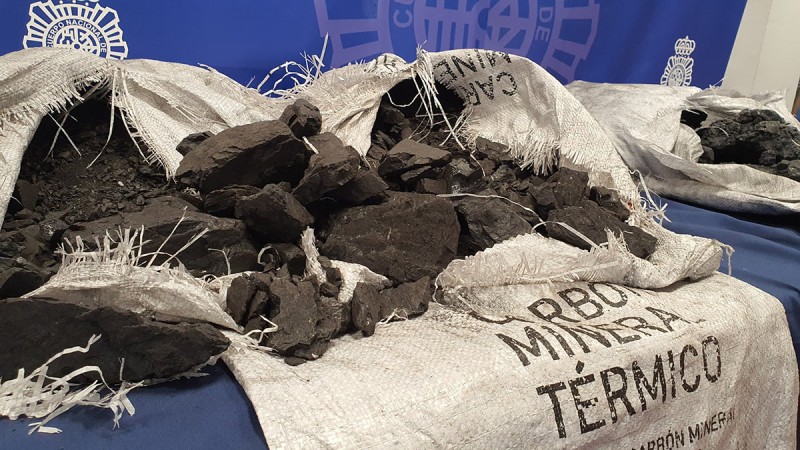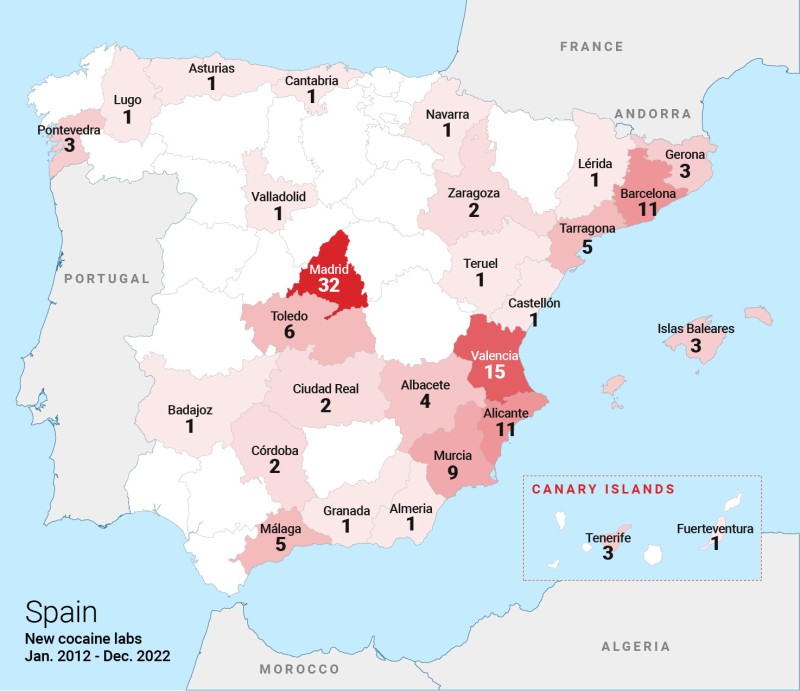In February last year, Colombian police intercepted a call from a suspected drug trafficker in Bogotá arranging a major cocaine sale for a buyer in Mexico. There was plenty available, the man bragged, with product on hand in Denver, Miami, and across the Caribbean.
Just a half decade earlier, the drugs would have almost certainly been sourced from Colombia or the nearby Andean regions of Peru or Bolivia. But times had changed. This coca, the man said, had been grown in Guatemala — a country over 2,000 kilometers to the northwest which has historically served mostly as a pitstop for traffickers.
The coca “gave good results,” the man told a person who appears to be a business associate, according to a transcript of the police wiretap. He had, he said, “a hundred boxes of high-end white shoes” — code for kilograms of cocaine — and “cooks” ready to start work in Guatemala and Mexico.
The conversation, obtained by reporters as part of a massive leak of files from the Colombian prosecutor’s office, provides more evidence of a momentous but still little-studied trend reshaping the global cocaine trade: The relocation of production out of its traditional Andean heartlands and into Central America.
About the Project
The development has been driven by several factors, notably the fragmentation of groups that controlled the trade. After a 2016 peace deal, the disarmament of the Revolutionary Armed Forces of Colombia (FARC) opened up cocaine production to both new and established gangs, who have experimented with techniques and supply chains. The Bogotá man’s conversations, for instance, were captured during an investigation into one FARC splinter group.
To better understand the trend, OCCRP and its partners analyzed leaked investigative documents, which they corroborated with court records, expert interviews, and on-the-ground reporting in five countries.
Data obtained from Guatemala’s Interior Ministry through freedom of information requests shows that coca cultivation has skyrocketed since the country reported finding its first coca plantation in May 2018. Similar expansions are underway in neighboring Honduras and Mexico, data from those countries shows, while Belize reported what appeared to be its first known coca plantation in December 2022.
Reporters found that, far from losing out, Colombians — who have historically controlled huge portions of the trade — are exporting their expertise and fashioning a niche for themselves in new operations in Central America and beyond.
The investigation gives new insight into how the processing of cocaine is relocating as well. As demand has surged in Europe, Asia, and Africa, labs have started to move out of Colombia and across the Atlantic. Dozens of new sites are found each year in Western Europe. One such lab in the Netherlands, run by a Colombian trafficker known as the “Heroin King of New Jersey,” could produce up to 200 kilograms of cocaine a day.
The emergence of labs in Europe and elsewhere has been facilitated by innovative shipping techniques — including sophisticated methods that camouflage liquid cocaine in textiles and other materials — which make shipments harder to track.
Drug trafficking has undergone a “moment of innovation” in recent years, ranging “from how to improve the networks, to how to use better tools and social media to purchase in large quantities,” Leonardo Correa, the coordinator of the United Nations’ Integrated Illicit Crop Monitoring System (SIMCI), told OCCRP.
When the FARC disarmed, groups of dissidents chose to hold on to their portions of the drug trade. Meanwhile, other international groups, such as Albanians and Serbians, have increasingly gained a foothold in the trade.
The result is that the cocaine trade has become “increasingly less cartelized,” Laurent Laniel, an analyst at the European Monitoring Centre for Drugs and Drug Addiction, said.
“More people are involved, which creates more opportunities for contacts, and more ideas of trafficking routes and smuggling methods,” Laniel said.
Along coca cultivation’s new frontiers, the plant’s arrival risks further waves of violence afflicting many communities that have already suffered heavily at the hands of trafficking gangs and state authorities for decades.
Cocaine’s History
Cocaine’s New Frontiers
Nestled among dense forests and coffee plantations in Mexico’s verdant Costa Grande region, the village of El Porvenir at first looks abandoned. With barely a dozen houses, its few streets were empty and its basketball court left to rust in the sun when reporters visited this spring.
But this quiet village sits on one of the many front lines of the cocaine trade’s dynamic expansion.
Local communities have grown cannabis and opium poppy in the region for decades, alongside other crops such as coconuts and mangoes. But after the collapse of coffee prices in the 1990s, illegal crops became one of the few profitable options left. Today, with opium prices also plummeting as U.S. consumers shift to using fentanyl, many are turning to coca.
“It’s the new economy: the diversification of illicit crops,” Arturo García Jiménez, a local community leader, told OCCRP’s partner El Universal.
Of the 171 coca plantations destroyed in Mexico between 2020 and May 2023, all but 13 were in the Costa Grande region in Guerrero state, according to Mexican military data. The vast majority of those were located in “ejidos” — communally owned farming areas like El Porvenir.
Drug trafficking groups in the region operate according to the Latin American expression “the bribe or the bullet” — that is, cooperate or die. Previous academic research and reporting shows how such groups often intimidate prominent community members, such as doctors and teachers, before dropping mutilated bodies on roadsides and carrying out murders and kidnappings of those who refuse to submit, or pay their “tax.”
For many locals, it’s safer to simply work with these gangs, García said. As the area’s sole buyers of illicit produce, crime groups can dictate which crops they want and how much they will pay for them.
He told OCCRP that, several years ago, a trio of Colombians arrived in the region. He believes that they brought the coca plant with them, which has now proliferated, and bought the leaves back from farmers.
“They’re technicians. They didn’t care about yield or quality,” García told OCCRP. “What they wanted was to produce and produce.”
The coca trade follows a trail of killings and forced displacement as groups vie for territorial control. In March, the commissioner of Corrales, an ejido 15 kilometers north of El Porvenir, told the Mexican newspaper Milenio that the entire population of one community had fled after an unnamed criminal group kidnapped and “disappeared” three people.
Milenio identified Corrales as one of many local ejidos that have fallen under the control of the crime syndicate La Familia Michoacana, infamous for carrying out execution-style killings and beheadings. Shortly after residents fled, the Mexican military destroyed nearly a hectare of coca in the ejido, according to the data obtained by OCCRP.
In El Porvenir, the military came looking for coca in September last year. A local coffee grower recalled how the village “filled up with soldiers,” and drones flew overhead during the raids. Yet after the soldiers left, she said, farmers simply moved their plants further up the mountain.
“Coca cultivation is here to stay,” García said. “What’s destroyed by the military is symbolic compared to the territory cultivated.”
The ‘Balloon Effect’
The relocation of El Porvenir’s farmers was a miniature example of what academics call the “balloon effect.” Squeeze cocaine production in one place, and it will simply move like air in a balloon to another. Crush one criminal group, and another rises up to take its place.
Similar dynamics are in part what is pushing production into Central America. By the time of the FARC peace deal, for instance, the rebel group controlled up to 40 percent of the world’s total cocaine trade, according to an estimate by the think tank Insight Crime. But rather than hindering production, the group’s splintering created what the UN’s drug agency described as a more competitive, diverse, and compartmentalized “free market.”
“There’s a sort of void in the market that not only affects Colombia,” Correa, of the UN body SIMCI, said. “The territories and routes that FARC controlled were interrupted … It made it possible to do the same elsewhere.”
Economic incentives have also helped push cultivation north. Correa said that a kilogram of cocaine sold in Colombia for $1,700 could fetch up to $15,000 by the time it reaches Central America. By producing cocaine closer to the point of sale, traffickers can benefit from higher prices while avoiding transport and other costs, as well as reduce the risks of their product being seized in transit.
Countries which used to serve mostly as transit points are now becoming producers in their own right, with cultivation often concentrated along established trafficking routes in remote areas or other locations where state presence is limited.
In Honduras, cocaine production grew rapidly after a 2009 military coup in the Colón and Olancho regions, both key points on the drug’s traditional route north. OCCRP’s analysis shows that in Guatemala, all but two of the 217 coca plantations found between 2018 and the end of 2022 were in the sparsely populated northeast — specifically the Izabal region, long known as a base for local traffickers.
Sometimes the illicit crops are introduced surreptitiously. Alan Ajiatas, the deputy chief of the Guatemalan Prosecutor’s Office against Narcoactivity, told OCCRP’s partner Guatemala Leaks that his office is investigating cases in which the crop was introduced to farmers without revealing to them that it was coca.
“They said, ‘It's a product that will be useful to you and we're going to pay you so much for the result,’” Ajiatas said. “So the people began to sow without knowing what it was.”
These new growers are still a long way from matching Andean producers. The UN’s drug agency estimates 230,000 hectares of coca were planted in Colombia last year alone, which would amount to over two percent of Guatemala’s total land area. By the end of last year, Guatemalan authorities had only ever destroyed roughly 110 hectares of the crop, and Mexico around 39 hectares.
But production is steadily expanding. Growers are experimenting with the crop to see where it takes hold, experts and authorities say. Some plantations have cropped up in some locations, such as the jungles of Panama or the mountainous Mexican state of Chiapas, only to vanish afterwards. This year, coca plantations were also found for the first time in remote corners of Mexico’s Michoacán state.
“They look for places where this crop can better develop,” Ludwig Reynoso, the secretary general of the Guerrero state government, told El Universal. “It still doesn’t have the necessary quality of the coca grown in Colombia.”
And it isn’t only cultivation that’s shifting, as recent developments across the Atlantic show.
Colombia’s Traveling Cooks
In July 2020, a team of Colombians arrived in a tinted-window bus to a horse riding school in the Dutch village of Nijeveen.
Inside the stables, their employers, a 10-man Netherlands-based criminal group, had built the largest cocaine laboratory authorities there had ever seen, capable of producing up to 200 kilograms of the drug per day, according to a prosecutor’s case file and subsequent court conviction.
On August 11, 2020, Dutch police found the largest cocaine laboratory ever found in the Netherlands hidden in a horse riding school in the village of Nijeveen.
At least 13 Colombians, all but two of whom were flown in for the job, would spend the next 10 days extracting, processing, and packaging what they hoped would amount to one metric ton of cocaine, prosecutors said. Upon arrival, they were told to hand in their phones and the door was locked behind them, according to their testimony.
The cooks worked on behalf of a fellow Colombian, Alejandro Cleves Ossa, who in turn answered to the Netherlands-based gang’s leaders, the arrest warrant shows.
Dubbed the “Heroin King of New Jersey” by age 23, Cleves had been extradited from Colombia to the U.S. and imprisoned on drug trafficking charges in 2010. He was granted an early release in 2018. Within two years, he had relocated to the Netherlands to coordinate cocaine production on behalf of a boss in Colombia, according to a Dutch police warrant obtained by OCCRP’s partner Follow the Money.
Dutch authorities raided the Nijeveen horse-riding school in August 2020. Cleves was convicted in March 2022 and given four years in prison. He did not respond to requests for comment.
The warrant and ensuing court case offered a rare insight into the workings of these new labs, which have started appearing more frequently outside South America over the past decade — some as far afield as Australia and Senegal. Dutch police say they have busted over 60 such labs since 2018.
Messages from the now-defunct encrypted communications tool EncroChat, hacked by police and cited in the arrest warrant, showed that the Netherlands-based gang had toured a variety of sites before settling on the riding school.
“The place is perfect,” one gang member wrote to a man in Colombia, who was supplying the cocaine.
“Let’s go wild,” the man replied.
Subsequent messages suggest the man in Colombia then sent more than 1.5 million euros to his partners in the Netherlands to invest in the lab, though the warrant does not state if and when the transfer took place.
For at least one Dutch gang member, it was the first foray into cocaine after years running a methamphetamine lab business in the Netherlands with Mexican associates. Searching for more profitable alternatives, he became “addicted” to the idea of processing cocaine, since that’s where “the real money” was, according to his court conviction, which cited his EncroChat messages.
The Dutch gang who built the Nijeveen lab — one of at least three they allegedly ran, according to the arrest warrant — added a layer of sophistication beyond what is typically found on the other side of the Atlantic: Industrial generators and custom-made boilers were soundproofed, and the stables were kitted out with an air purification system to keep chemical smells from attracting attention.
It’s not clear how much the lab cost, but two experts interviewed by OCCRP estimated that similar facilities could take anywhere from 200,000 to 500,000 euros to build. In the hacked chats cited by police, one Dutch gang member speculated that his boss had invested a total of $2 million in one of their other labs.
The location offered another advantage. In South America, drug producers often struggle to obtain high-quality chemical precursors, such as potassium permanganate. But inside the European Union, criminal groups — often with decades of experience producing synthetic drugs — can obtain the chemicals directly from legal producers.
Dutch court convictions from separate cases show that these deals are often handled by middlemen, who claim the chemicals will be used for legal activities such as art restoration.
The hacked chats from the Nijeveen case show that Dutch gang members discussed spending 300,000 to 400,000 euros on “liquids” — a reference to chemical precursors — in early June, when the lab was under construction.
“The Dutch have everything — harbors, distribution networks, locations, chemicals, etc. — but they lack the expertise. The Colombians have the product and the expertise,” Martin van Nes, the national prosecutor for cocaine trafficking in the Netherlands, told OCCRP. "You could say it’s almost a marriage of necessity.”
Reporters have discovered that this expertise is being sent around the world. The Bogotá-based trafficker caught on the Colombian wiretaps not only said he sent a team of “cooks” to Guatemala to process his Central American cocaine — he also discussed sending them for a job in Amsterdam.
Others have been sent to do similar work in Spain: one Colombian cocaine cook who worked in a lab outside Madrid told OCCRP’s Spanish partner Narcodiario he was hired to manage a team of six people and was paid around 450 euros per “unit” — usually a reference to kilograms — produced. (See box for more detail.)
“It’s what we know how to do well,” the cook said, speaking on condition of anonymity. “I was born in a region where this is the day-to-day work of every family, and you learn how to work with coca before reading or writing.”
The Cocaine Trade’s ‘Miserable Base’
Cocaine “cooks” work in what authorities describe as unhealthy and inhumane conditions. Shifts are long and workers often sleep and eat inside the sites.
Camouflaged Shipments
The shift in cocaine production and processing has been driven by increasingly sophisticated shipping methods.
Much of the cocaine base materials make their way to Europe hidden in legal products. This can involve mixing it into melted plastic that is then reshaped or dissolving the cocaine into liquids and pouring the mixture to “impregnate” it into clothing or other materials.
Such techniques, which first appeared in the early 2000s, have increased considerably over the last four years, according to Jorrit van den Berg, a Dutch forensic scientist.
“The scale of those operations has been increasing as well,” van den Berg said. “The smuggling of cocaine in carrier materials has evolved into a second big flow into Europe.”
“Cees,” a 44-year-old Dutchman convicted in 2021 of running a meth lab where he employed Latin American cooks, told OCCRP that he had also considered setting up a lab to extract cocaine from carrier materials. The idea, he said, was to avoid costs — such as having to bribe port officials or pay people to break into shipping containers — and thereby offset recent drops in prices due to overproduction in Colombia.
“It makes more sense, money-wise,” Cees told OCCRP, agreeing to be identified only by his nickname. “They’ve been cranking out so much product [in South America], wholesale prices have dropped.”
In one joint investigation with British and Dutch authorities, Colombian prosecutors tracked a transnational crime group that planned to export cocaine mixed into materials such as palm oil, charcoal, coffee, and fertilizer. (It is unclear if these plans went forward.)
According to an internal report summarizing the investigation's findings, a father-son duo of chemists helped process the cocaine and then implanted it into those legal goods in clandestine Colombian labs. Before exporting the drugs, the gang sent trial shipments of unadulterated charcoal to European ports to test each country’s customs controls. Both were among at least 27 detained in Colombia by July this year. Nineteen of them are currently appealing.
Once on the other side of the ocean, the drug is extracted through techniques such as flushing the carrier material with water and solvents. In the Nijeveen lab, the team first extracted the cocaine base from the coal into which it had been mixed, and then crystallized it before packing it, ready for sale. Van den Berg told OCCRP that the sophisticated nature of this type of camouflaging has rendered some of the standard screening techniques redundant.
But getting the recipe right isn’t easy. One trafficking group, dubbed by Colombian prosecutors as the “Morfhox Cartel,” experimented with novel ways of evading detection on their shipments into the U.S. and Europe, including by shipping one kilogram of liquid cocaine to the Bahamas, according to a Colombian indictment against the group.
However, when one gang member in the Bahamas tried to return the drug to its original state after being taught the perfect “formula,” he only managed to extract 40 grams. Dozens of members of the group were arrested across Colombia in 2018. He and others are currently appealing.
Freek Pecht, an anti-drugs coordinator with the Dutch police, said the Colombians brought to Europe were often the same ones who hid the cocaine in the carrier material back home because they knew the “specific code” to “unlock” the shipments.
“If you fumble with that recipe then things go wrong, you’ll either get a much lower return or you’ll screw up the whole batch, and you’ll have nothing,” he told OCCRP’s partner Knack.
This year, Spanish police raided a laboratory in northwestern Galicia which was the first of that scale in Europe to be found making the drug directly from a bulk import of the “base paste,” the initial rudimentary product often made by the same farmers who harvest the plant, and not hidden in carrier materials.
As in Nijeveen, the Galician site could produce up to 200 kilograms of cocaine a day.
Base paste is cheaper than subsequent cocaine products. As a result, processing it into powder in Europe can lower financial losses if a shipment is seized. It also means a higher return on the European side, where one thousand kilograms of cocaine can bring in as much as $80 million, according to an analysis by Global Initiative, a non-government organization focused on organized crime.
“The phenomenon is going to expand exponentially, fundamentally due to what’s profitable,” Emilio Rodríguez Ramos, chief of the Spanish investigation into the laboratory, told OCCRP’s partner Narcodiario.
Van Nes, the Dutch prosecutor, said authorities in Antwerp and Rotterdam had been seizing far more cocaine in recent years, and that it was natural for traffickers to respond by trying to “spread risk, as any sound financial market investor would do,” by varying methods, routes, and ports.
"Between criminal organizations and law enforcement it’s a never-ending cat-and-mouse game,” he said.
Data Analysis by Ignacia Velasco
Yelle Tieleman (Follow the Money) contributed to this story.
